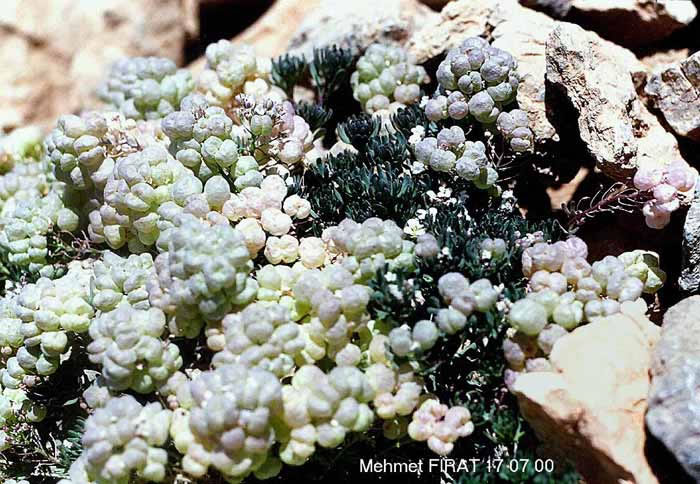Didymophysa aucheri: Red Data Book of Armenia

CR B 1 ab(iii) + 2 ab(iii)
Category. Critically endangered species. Two sub–populations are known from Aragats massif and Gegham mountain range. The extent of occurrence and the area of occupancy are less than 10 km2. The area of distribution is severely fragmented. The species is on the verge of extinction caused by global climate change. It was included in the first edition of the Red Data Book of Armenia under Category 2: Rare species. It is not included in the Annexes of CITES and that of the Bern Convention.
Description. Loosely cespitose perennial plant 5–10 cm, with prostrate or ascending stems. Leaves slightly fleshy, at base cuneate, narrowed into petiole, deeply lobate; lobes 3–5, linear. Pedicels filiform, 5–10 cm long, oblique upward oriented. Flowers white. Silicle 4–8 x 8–13 mm, inflated, double, with globose valves and 2–4 seeds.
Distribution. In Armenia it occurs in Aragats (crater of the Aragats mountain) and Gegham (Aghusark Mountain of Gegham mountain range) floristic regions. AOO is 8 km2, the number of locations is 2, the distance between which is 72 km. The general area of distribution includes eastern part of the Greater Caucasus (Shakh–Dagh), Lesser Caucasus (mountain peak Gyamish), East Anatolia, Iran, Iraq, Central Asia.
Ecological, biological and phytocoenological peculiarities. Grows in alpine belt, at the altitudes of 3450–3900 meters above sea level, on screes near the mountain peaks, on stony slopes. Flowering in July, fruiting in August.
Limiting factors. Restricted extent of occurrence and area of occupancy, global climate change.
Conservation actions. No conservation actions. Necessary: monitoring of the population state.
Suggestions
 The Ministry of Environment sent a letter international partners to draw their attention to the real danger of environmental disasters as a result of Azerbaijan's large-scale aggression towards the territory of Armenia
The Ministry of Environment sent a letter international partners to draw their attention to the real danger of environmental disasters as a result of Azerbaijan's large-scale aggression towards the territory of Armenia
 Vicia pisiformis: Red Data Book of Armenia
Vicia pisiformis: Red Data Book of Armenia
 Vavilovia formosa: Red Data Book of Armenia
Vavilovia formosa: Red Data Book of Armenia
 Trigonella capitata: Red Data Book of Armenia
Trigonella capitata: Red Data Book of Armenia
 Trigonella astroides: Red Data Book of Armenia
Trigonella astroides: Red Data Book of Armenia












